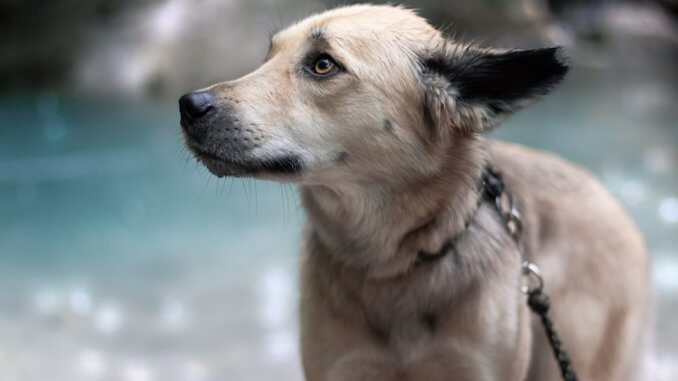
Not to be mistaken with the Labrador Husky, a distinct breed from Canada, the Husky Lab Mix—also affectionately known as a Labsky or Huskador—is an absolute treasure for any active and dedicated owner. Bred from two of America’s most cherished dog breeds, this hybrid inherits many wonderful traits from the Labrador and Siberian Husky.
For instance, I find the Labrador Retriever incredibly friendly and smart, and the Siberian Husky has a striking appearance with a thick coat and captivating eyes. Imagine having a breed that combines those traits. That’s why I’m thrilled to explore the traits of this mix. Hence, this article will look at the breed’s fascinating history, distinctive features, and characteristics that set it apart, and even guide you on caring for a Husky Lab Mix.
TABLE OF CONTENTS
Husky Lab Mix Quick Summary
Husky Lab Mix Parent Breeds
With two working parents, this mix was bred to be a high-energy companion dog. Hence, it requires exercise and a secure backyard, as Huskies are known to be expert escape artists. It can be difficult to predict traits of crossbreeds, but the Husky Lab Mix is highly likely to be affectionate, playful, and friendly. As it’s a crossbreed, it’s not registered with any Kennel Clubs. Let us learn more about the parent breeds.
Siberian Husky
The Siberian Husky is a breed that originally hails from Northeast Asia, specifically Siberia. They were bred by the Chukchi people, primarily to pull sleds over long distances in harsh Arctic conditions.
Physical Characteristics
Siberian Huskies are medium-sized dogs, known for their dense double coat that comes in many colors and striking patterns. Their eyes are perhaps their most captivating feature, often blue or heterochromatic (different-colored eyes). I find their athletic build particularly impressive, as it highlights their capability for endurance and speed. Typically, they weigh between 35 and 60 pounds, with a height ranging from 20 to 23.5 inches at the shoulder.
Temperament and Behavior
Siberian Huskies are known for their friendly and gentle temperament, but they also possess a bold and independent streak. From my perspective, this makes them quite the charismatic breed. They are highly energetic and require ample exercise to stay happy and healthy. I appreciate their intelligence and eagerness to work, although these traits also mean they can be mischievous if not properly engaged. Huskies are social animals and love being part of a pack, whether interacting with other dogs or their human family.
Labrador Retriever
The Lab’s history of service moves me. Affectionately known as the Lab, it originated in Newfoundland, Canada, initially used by fishermen to help retrieve fishing nets and loose fish, and later refined as a hunting retriever in Britain.
Physical Characteristics
Labrador Retrievers are sturdy, medium to large dogs known for their dense, water-resistant coat, which comes in black, yellow, and chocolate. One thing I particularly admire is their expressive eyes which reflect a kind and friendly spirit. They typically weigh between 55 and 80 pounds and stand about 21.5 to 24.5 inches tall at the shoulder. Their build is one of strength and agility, which complements their energetic nature.
Temperament and Behavior
Labrador Retrievers are renowned for their friendly and outgoing nature. They are incredibly sociable, which makes them excellent family pets and companions. I’ve observed that Labs are always eager to please, making them highly trainable—a trait that’s deeply appreciated by both novice and experienced dog owners alike. They possess a high level of energy and require regular exercise to maintain their health and happiness. Their adaptability and gentle temperament also make them ideal candidates for roles such as service dogs or in search-and-rescue operations.
Physical Characteristics of a Husky Lab Mix
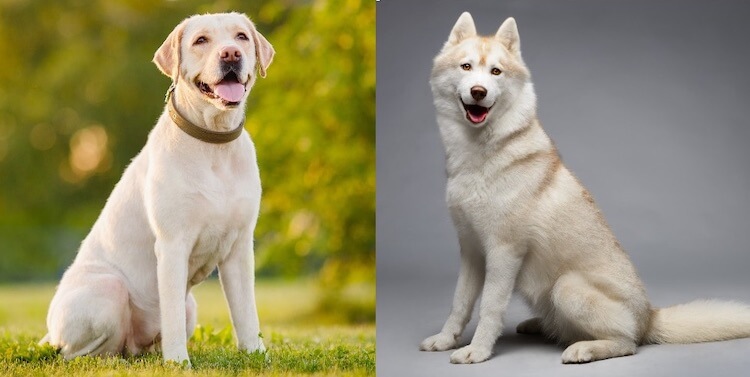
You can never be certain exactly what they will look like, but you can expect a unique blend of both parent breeds. These dogs generally have a lean and muscular build, and their double coat, which ranges from short to medium-length, is wonderfully soft to the touch.
They often have expressive faces, complete with eyebrows and sometimes distinctive face masks, adding to their charm. As for their ears, they can vary between floppy, typical of Labs, or erect like those of a Husky. I find this mix of features particularly endearing as it gives each Husky Lab Mix its unique look.
An interesting trait that some of these mixes may exhibit is heterochromia—having two different colored eyes. I always remind people that this is a perfectly natural characteristic and poses no harm to the dog.
Height and Weight
In my observations, male Husky Lab Mixes tend to be slightly larger, typically weighing between 45 and 80 pounds, while females usually range from 35 to 70 pounds. Their height can vary significantly, from 20 to 28 inches, with 25 inches being about average to the withers. This places them in the medium to large breed category, making them robust companions for those who enjoy an active lifestyle.
Coat and Colors
The coat color of a Husky Lab Mix can vary widely. From the Husky side, they may inherit colors ranging from black to pure white, including cream, brown, or gray combinations. From the Labrador side, they might display solid colors like yellow, chocolate, black, or even red. No matter the color, their double coats are functional as well as attractive, helping them maintain a stable body temperature throughout the year. The coat is short to medium in length and quite dense due to its undercoat, which I find makes these pets quite cuddly.
They shed moderately throughout the year, but shedding increases during the spring and autumn. I always advise potential owners to be prepared for a bit of extra grooming during these times to help manage their fur.
Husky Lab Mix Puppies
Typically, a Husky Lab Mix puppy will cost between $400 and $800, depending on factors like the breeder’s reputation, location, and the puppy’s lineage. This price range reflects the popularity and specific breeding requirements of both parent breeds.
When it comes to litter size, the mix can be quite unpredictable due to the differing characteristics of the Husky and Lab. You might find litters as small as 4-6 puppies, which is common for Huskies, or as large as 6-8 puppies, more typical of Labs. This variability adds a bit of surprise and excitement to the process of welcoming new puppies!
Predicting the appearance of Husky Lab mix puppies can be equally uncertain. They may inherit the solid color of their Labrador parent or display a mix of colors like their Husky counterpart. Regardless of their color, these puppies will inherit the soft, double-coat characteristic of both breeds, making them irresistibly cuddly.
I’ve noticed that Labrador Retrievers tend to mature slowly, often retaining their puppy-like behavior into early adulthood. This trait can carry over to the Husky Lab Mix, where you can expect them to reach full maturity between 18 months and 2 years. This extended puppy phase can be quite delightful but also demands patience and consistent training to harness their energy and potential. If you’re prepared for a lively and prolonged puppyhood, this mix might just be the perfect addition to your family.
Labsky Personality and Temperament
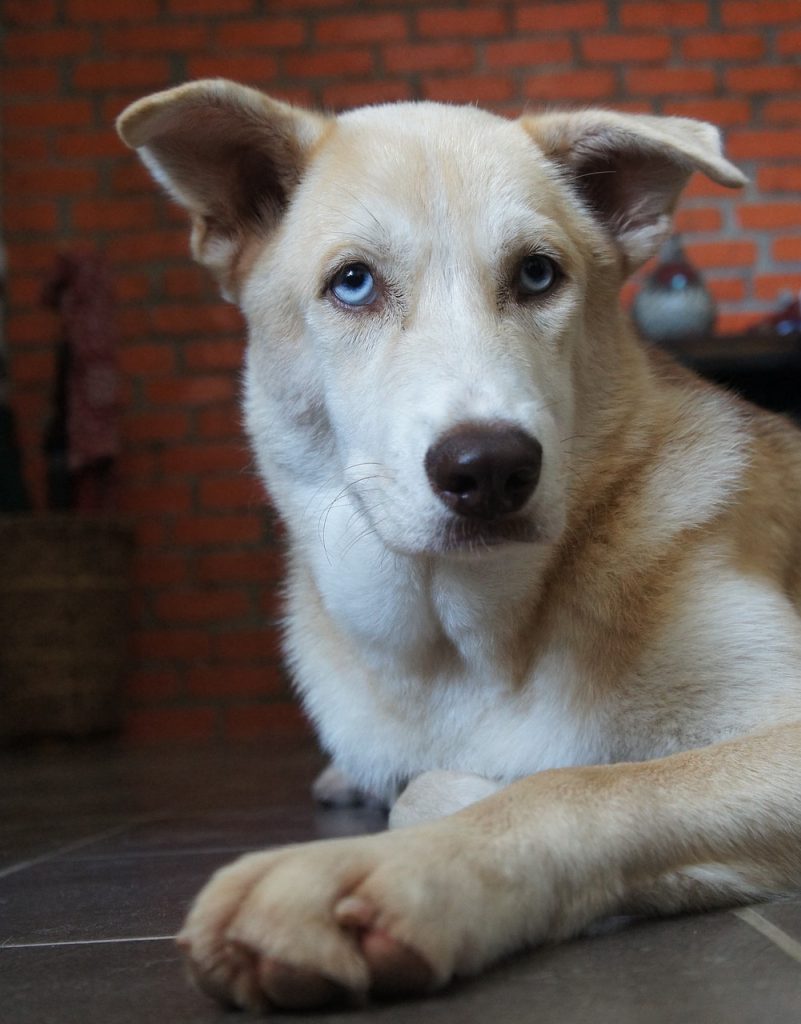
Both parent breeds have a sweet nature and are gentle, making this mix a popular choice for families looking to add a new member.
One thing I’ve noticed about this mix is that they thrive in a home where there’s always someone present. These dogs form strong attachments to their family and can suffer from separation anxiety if left alone too often. They need interaction and can become anxious and bored, which might lead to some less desirable behaviors, like chewing or digging if they’re not engaged.
Since both the Labrador and Husky were bred as working dogs, the Husky Lab Mix is naturally energetic and loves to be involved in activities. They relish playtime and any form of interaction with their family. Despite their energy, they typically have a low prey drive, as they’re bred more for companionship than hunting.
While Labs tend to only vocalize when necessary, Huskies are known for being quite talkative. This mix may inherit the Husky’s chattiness, so new owners should be prepared for a dog that likes to express itself. Despite this, both the Husky and Lab are known for their low levels of aggression and protectiveness, which means this mix is not the best candidate for a watchdog role; they are more likely to greet strangers with a wagging tail than a growl.
Both breeds are confident and intelligent, capable of assessing situations for safety or threat. With proper socialization, they are extremely friendly towards strangers and other dogs, often getting along well with other household pets too.
Do Husky Lab Mixes Make Good Family Dogs?
Absolutely! The Husky Lab Mix makes an excellent family pet. They are known for being particularly gentle and calm around children, relishing playtime and any form of human contact. With appropriate socialization and consistent training from a young age, a Husky Lab Mix typically grows into a well-rounded and sweet-natured dog. They often integrate well with other household pets, contributing to a harmonious home environment. This blend of traits makes them not just pets, but cherished family members.
Huskador Care Guide
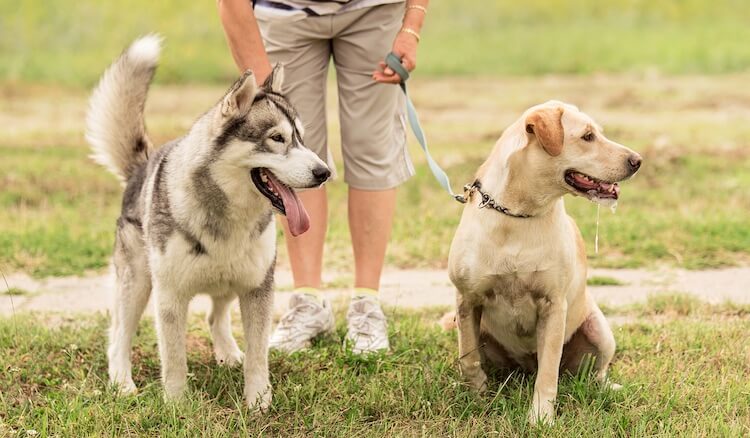
I find that provided that owners can meet their grooming and exercise requirements, the Husky Lab Mix is suited to novice owners. However, any owner will need to be committed to their daily exercise routine. Here is a comprehensive look at this pet’s needs.
Feeding
As someone who has cared for many dogs, I understand the importance of getting their diet right from the start. Here are feeding guidelines for this breed.
Feeding at Different Life Stages
In the puppy stage, a Husky Lab Mix requires a diet rich in proteins and fats to support rapid growth and development. I usually recommend feeding high-quality puppy food that’s specifically formulated for medium to large breeds. These foods ensure that your puppy gets the right balance of nutrients needed to grow healthy bones, muscles, and joints. Typically, you should feed puppies three to four small meals per day. This helps to maintain steady energy levels and supports their fast metabolism.
Adult dogs should be fed twice a day with high-quality adult dog food that matches their energy level and health needs. The choice between grain-free, limited ingredient diets, or conventional dog food often depends on their specific health requirements or any sensitivities they might have.
As your Husky Lab Mix enters the senior years, the dietary needs will evolve again, typically requiring adjustments to support changing activity levels and metabolism. Senior dogs often benefit from foods that are easier to digest and lower in calories, but still rich in essential nutrients to help maintain their health and mobility.
I recommend switching to a senior-specific dog food formula that includes joint-supporting supplements like glucosamine and chondroitin, which are especially beneficial for older dogs who may start to experience joint pain or stiffness. It’s also important to keep an eye on their protein intake to ensure it’s sufficient to help maintain muscle mass, which can decline with age.
Additionally, regular veterinary check-ups are crucial at this stage to monitor any underlying health issues such as kidney function, arthritis, or heart health, and to adjust their diet accordingly.
Transitioning to New Pet Food
Switching your Husky Lab Mix to a new type of food should be a gradual process to avoid digestive upset. Over a week or so, you can mix increasing amounts of the new food with decreasing amounts of the old food. This slow transition helps their digestive system adjust without much fuss.
Hydration
Keeping your Husky Lab Mix well-hydrated is just as important as their diet, especially given their energy levels. Always make sure fresh water is available, particularly after exercise or in hot weather. I always remind pet owners that a good rule of thumb is to check if the water bowl is full and clean it regularly.
Diet for Special Needs
Some Husky Lab Mixes may have specific dietary needs based on health issues like allergies or sensitivity to certain foods. In such cases, consulting a veterinarian to tailor their diet can make a big difference. They might recommend hypoallergenic food or special formulas that cater to these needs.
Grooming
Grooming a Husky Lab Mix is quite the adventure, given their unique coat characteristics from both parent breeds. I’ve learned that maintaining their coat not only keeps them looking great but also supports their overall health and comfort. Let’s walk through the various grooming needs of this delightful mix.
Brushing
Regular brushing is essential for Husky Lab Mixes, especially because they inherit the thick double coat of the Husky, which can shed heavily. I recommend brushing them several times a week, and daily during shedding season, to help manage loose fur and prevent matting. Using a de-shedding tool or a sturdy bristle brush works wonders in pulling out the dead undercoat and stimulating the skin.
Bathing
While these dogs don’t require frequent baths, I find that bathing them every few months, or when they get particularly dirty, helps keep their coat clean and reduces odors. It’s important to use a dog-specific shampoo that moisturizes and protects their double coat.
Nail Trimming
Keeping their nails trimmed is another key aspect of grooming. Long nails can cause discomfort and even lead to problems with walking. I suggest you trim your dogs’ nails every month or so, or whenever you hear them clicking on the floor. If you’re not comfortable doing it yourself, a vet or groomer can help.
Ear Care
Due to their potential for erect or floppy ears, Husky Lab Mixes can be prone to ear infections, especially if they have the floppy ears of a Lab. Hence, check their ears weekly for signs of dirt, buildup, or infection, and gently clean them with a vet-approved ear cleaner.
Dental Care
Dental hygiene is crucial for preventing bad breath and gum disease. I recommend brushing their teeth several times a week with dog-specific toothpaste and providing dental chews to help keep their gums and teeth healthy.
Training and Exercise
With their energetic nature and intelligence inherited from both parent breeds, providing the right training and exercise regimen is key to fostering a happy and well-behaved companion. Here are a few tips:
Training
Training will heavily depend upon which traits they inherit from their parents. For instance, Huskies harbor a stubborn streak and often have ideas of what they want to do. On the other hand, Labs are intelligent and very eager to please their human companion, responding well to positive reinforcement and mastering new commands quite quickly.
When you start training, you will require patience and lots of repeated sessions. Consistent training and interactive training involving all family members is key to keeping the dog engaged and combating stubbornness. Their intelligence means they will require lots of mental stimulation to prevent boredom, especially when left alone.
Exercise
If they are not sufficiently exercised, Huskies and Labs can become bored and frustrated easily. They will find their form of fun. For instance, Huskies love digging backyards, couches, and whatever they can! In contrast, Labs usually chew furniture, shoes, and anything else!
Therefore, a Husky Lab Mix should be thoroughly exercised for at least one hour each day; they need dedicated time to burn off energy. This can be in the form of walking (off-leash is more effective), hiking, swimming, long walks, or a run around the park. Because they are intelligent, this mix is suited to canine sports such as agility and flyball. This will help mentally and physically challenge them.
Mental Needs
Meeting the mental needs of a Husky Lab Mix is just as crucial as addressing their physical requirements. These intelligent and energetic dogs thrive on mental stimulation and need plenty of opportunities to engage their minds. I’ve found that regular training sessions, interactive playtime, and puzzle toys are essential for keeping them mentally sharp and fulfilled. Without enough mental stimulation, they may get bored and start exhibiting undesirable behaviors. So, it’s important to include new activities and challenges in their routine to keep them interested and happy. Providing outdoor adventures or games that tap into their natural curiosity, like scent-based activities, can also help keep them engaged.
Socialization
I’ve found that introducing them to different sights, sounds, and smells from a young age helps prevent fearfulness and anxiety in new situations. Whether it’s trips to the park, visits to pet-friendly stores, or encounters with other dogs at a dog park, exposing them to diverse stimuli helps build their confidence and adaptability.
It’s also important to provide plenty of opportunities for positive interactions with people of all ages, including children. Teaching them how to appropriately interact with kids can help prevent any potential issues and ensure they remain gentle and tolerant companions.
I always encourage fellow pet parents to make socialization a priority and to continue exposing their Husky Lab Mix to new experiences as they grow older. By doing so, they can help their furry friend become a well-adjusted and socially adept member of the family.
Husky Lab Mix Health Issues
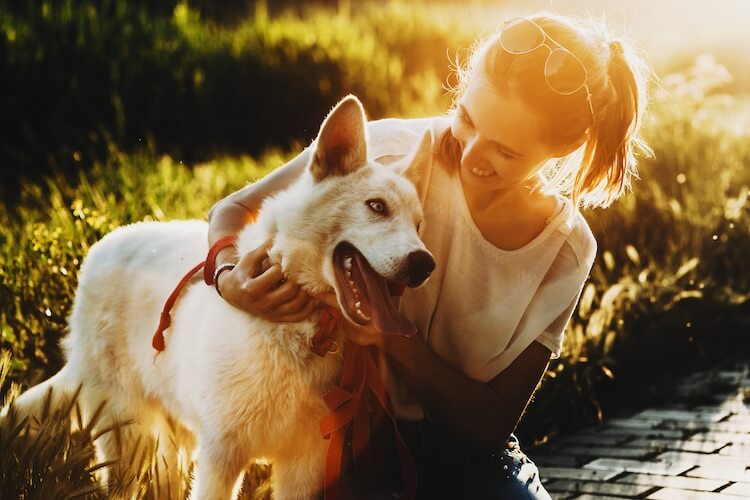
It is estimated that a Husky Lab Mix will live for an average of 12 years. However, this can span from 10 to 15 years based on their parents’ typical life spans. Unfortunately, both parent breeds have known health conditions that can affect their quality of life. Hence, your Huskador may suffer from the following conditions:
Hip Dysplasia
Hip dysplasia is a common health issue in Husky Lab Mixes, and it’s something I’ve come across quite often in my studies and interactions with fellow pet owners. This condition occurs when the hip joint doesn’t develop properly, leading to instability and eventually arthritis. Symptoms can include limping, difficulty getting up, reluctance to exercise, and decreased range of motion in the hips. Genetics can play a role in hip dysplasia, so it’s important to choose a reputable breeder who screens their breeding dogs for this condition.
Additionally, factors like rapid growth, excessive weight, and inadequate nutrition can exacerbate the problem. While hip dysplasia can’t be cured, management options such as weight management, exercise moderation, and medications can help alleviate symptoms and improve your Husky Lab Mix’s quality of life. Regular veterinary check-ups are crucial for early detection and management of this condition.
Progressive Retinal Atrophy (PRA)
Progressive Retinal Atrophy (PRA) is another health concern that Husky Lab Mixes may face, and it’s an issue I’ve encountered in my research and discussions within the dog community. This inherited condition affects the retina, leading to progressive degeneration of the photoreceptor cells and eventual blindness. Symptoms typically begin with night blindness, where the dog has difficulty seeing in low light conditions, and progresses to complete blindness over time. PRA is caused by a genetic mutation that affects the development and function of the retina.
While there is no cure for PRA, early diagnosis through genetic testing can help breeders avoid mating dogs carrying the gene mutation. Unfortunately, since PRA is progressive and irreversible, treatment options are limited to supportive care to help the dog adapt to their blindness and maintain their quality of life. Regular veterinary check-ups are essential for monitoring the progression of the disease and managing any associated symptoms.
Obesity
Obesity is a significant health concern for Husky Lab Mixes, given their hearty appetites and tendency to gain weight if not properly managed. I’ve observed that excessive weight can lead to a variety of health issues, including joint problems, heart disease, and diabetes. Causes of obesity in this mix can include overfeeding, lack of exercise, and genetic predisposition. As a responsible pet owner, it’s crucial to monitor your dog’s weight and adjust their diet and exercise regimen as needed to maintain a healthy body condition. Providing regular exercise, portion-controlled meals, and healthy treats can help prevent obesity and keep your Husky Lab Mix in optimal health. Regular veterinary check-ups can also help identify and address any weight-related issues early on, ensuring your dog lives a long and healthy life.
FAQs about the Husky Lab Mix
Are Husky Lab Mixes good with children?
Yes, Husky Lab Mixes can be excellent companions for children when properly socialized and trained. They are known for their gentle and playful nature, making them great playmates for kids. However, it’s essential to supervise interactions between the dog and children, especially younger ones, to ensure mutual respect and safety. Teaching children how to interact appropriately with the dog and respecting their boundaries is crucial for fostering a positive relationship.
Do Husky Lab Mixes require a lot of exercise?
Yes, Husky Lab Mixes are active and energetic dogs that require plenty of exercise to stay healthy and happy. They inherit their parents’ working dog genes and thrive on activities that engage both their bodies and minds. Daily walks, runs, hikes and playtime in a securely fenced yard are essential to meet their exercise needs. Without enough physical activity, they may become bored and restless, leading to undesirable behaviors like chewing or digging.
Do Husky Lab Mixes shed a lot?
Yes, Husky Lab Mixes typically have a moderate to high shedding tendency due to their double coat, which they inherit from both parent breeds. Regular grooming, including brushing several times a week, can help manage shedding and keep their coat healthy and free of mats. Additionally, seasonal shedding can occur, especially during the spring and fall when they may shed more heavily.
Are Husky Lab Mixes easy to train?
Husky Lab Mixes are intelligent dogs that are eager to please, making them relatively trainable with patience and consistency. However, they can also inherit the independent and stubborn nature of both parent breeds, which may present some challenges during training. Positive reinforcement methods, such as rewards and praise, tend to work best with this mix. In addition, early socialization and obedience training are essential to help them develop into well-behaved and well-adjusted companions.
Your Home Needs a Heartwarming Huskador
The Husky Lab Mix embodies the essence of a devoted and affectionate companion, making them a cherished addition to any active family environment. With their boundless loyalty and playful spirit, they thrive in households where love and attention abound. These dogs are not meant for a sedentary lifestyle; they crave plenty of outdoor adventures and a secure backyard where they can stretch their legs and explore to their heart’s content.
Whether it’s a game of fetch in the yard or a hike in the great outdoors, the Husky Lab Mix is always up for an adventure with their beloved human companions.
Their gentle demeanor around children further solidifies their role as a beloved family pet, provided their exercise and grooming needs are met. With proper care and affection, the Husky Lab Mix will undoubtedly become a treasured member of the family, bringing joy, laughter, and endless cuddles into the home.
Could this mix be your latest addition to the family? Let us know below.
Other Labrador Retriever and Husky Mixes
If you’re interested in learning about other Lab mixes or Siberian Husky mixes, check out the hybrid dog breeds below.
Lab Mixes
- German Shepherd Lab Mix
- Pitbull Lab Mix
- Blue Heeler Lab Mix
- Golden Retriever Lab Mix
- Rottweiler Lab Mix
- Beagle Lab Mix
- Border Collie Lab Mix
- Australian Shepherd Lab Mix
- Labrabull
- Labradoodle Dog
- Boxador
- Mini Labradoodle
- Australian Labradoodle
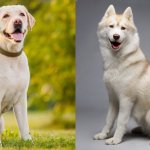
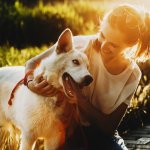
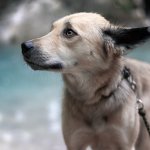
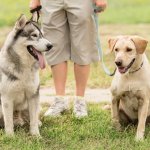

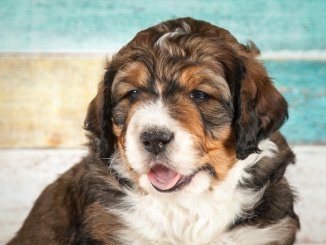
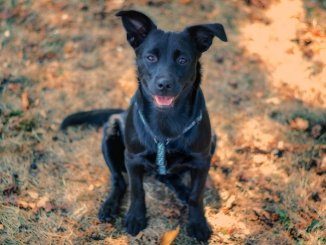
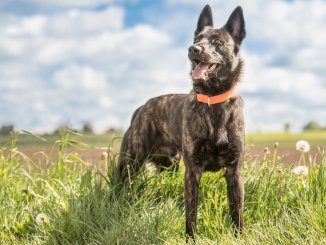
My Chocolate lab got preg.by a husky. She is 4 years old going to be 5 in nov.3 this year.